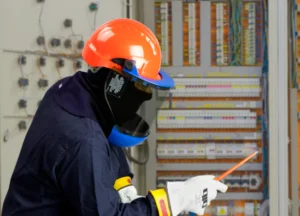Selecting the right Personal Protective Equipment (PPE) is not as straightforward as grabbing a helmet and gloves. Every industry has its own risks, and improper PPE can lead to accidents, injuries, and compliance issues. This practical guide outlines how companies can choose the right PPE tailored to their unique operational environments—whether it’s construction, oil and gas, logistics, or manufacturing.
Why PPE Selection Matters
Poor PPE choices can have serious consequences:
- Injury or fatality from insufficient protection
- Non-compliance penalties from HSE audits
- Employee dissatisfaction due to discomfort or mobility issues
- Wasted budget on unused or incorrect gear
An intentional, industry-specific PPE strategy ensures maximum protection, regulatory alignment, and optimal return on investment.
Step-by-Step Guide to Choosing the Right PPE
Step 1: Conduct a Thorough Hazard Assessment
Start by identifying the specific hazards your employees are exposed to:
- Physical hazards: moving machinery, falling objects, sharp tools
- Chemical hazards: solvents, acids, flammable liquids
- Biological hazards: viruses, bacteria, mold
- Environmental hazards: extreme heat, cold, dust, noise, UV exposure
Create a hazard map of your facility or project site. This will serve as the foundation for your PPE plan.
Step 2: Consider the Nature of Each Role
PPE needs vary not just by industry—but also by role. Ask:
- Does this role involve direct contact with machinery?
- Is it indoors or outdoors?
- Does the worker handle chemicals or operate heavy equipment?
- How mobile or agile does the worker need to be?
Each role should have its own PPE checklist based on task-specific risks.
Step 3: Match PPE to Identified Risks
Here’s a simplified match-up chart:
| Hazard Type | Recommended PPE |
|---|---|
| Falling Objects | Hard hats, steel-toe boots |
| Chemical Splash | Goggles, face shields, chemical-resistant gloves |
| Fire/Explosion Risk | Flame-resistant (FR) coveralls, anti-static gear |
| Airborne Contaminants | Respirators, masks, SCBA |
| High Decibel Noise | Earmuffs, earplugs |
| Sharp Materials | Cut-resistant gloves, arm guards |
| Confined Space Entry | Harnesses, gas detectors, helmets with lights |
Step 4: Ensure Compliance with Standards
Always check that PPE meets relevant safety standards such as:
- NIOSH, ANSI, and OSHA (for international-grade products)
- ISO certifications
- DPR and HSE Nigeria standards for local regulations
Non-certified PPE can fail in critical situations, putting lives and your company’s reputation at risk.
Step 5: Prioritize Comfort and Fit
Even the best PPE is useless if it’s too uncomfortable to wear. Always:
- Offer multiple sizes
- Choose breathable materials for hot environments
- Use adjustable straps or elastic for flexibility
- Avoid overly bulky items unless necessary
Encourage employees to give feedback during trial periods.
Step 6: Plan for Maintenance and Replacement
Establish a lifecycle management system:
- Regular inspection and cleaning
- Immediate replacement of damaged PPE
- Stock rotation and expiry checks
- A centralized PPE inventory tracking system
This prevents gear failure and ensures full protection at all times.
Step 7: Educate and Train Your Workforce
Even the right PPE is ineffective without proper usage. Training should include:
- Donning and doffing procedures
- Equipment storage and hygiene
- Emergency response with PPE
- How to spot signs of wear and tear
Provide manuals, signage, and practical demos during onboarding and refresher sessions.
Common PPE Mistakes to Avoid
- Buying “one-size-fits-all” gear for a diverse workforce
- Using chemical gloves for heat protection or vice versa
- Ignoring PPE compatibility with other equipment (like harnesses or helmets)
- Not involving HSE officers in procurement decisions
Conclusion
Choosing the right PPE is not just about checking boxes—it’s about protecting lives, preserving operations, and staying compliant. By assessing risks, consulting with professionals, and prioritizing user comfort, companies can implement a PPE program that’s both effective and sustainable.
Need Help Choosing PPE? We’ve Got You Covered.
At SOC Energy Services Ltd, we help organizations assess risks and supply certified, industry-specific PPE that meets local and global standards. Get in touch for expert support today.





